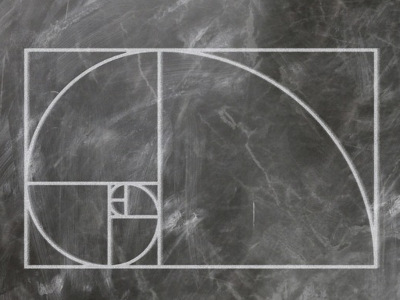Is there a formula for beauty? A measurable form that guarantees harmonious proportions? Some people believe that there is a number that answers these questions: the irrational number Φ . Let’s find out more about an interesting mathematical phenomenon that can also be used in art lessons.
Let’s start by looking at its history and what it actually means.
Around 300 BC, the Greek mathematician Euklid was the first to describe the golden ratio, although it didn’t have that name yet.
You can imagine it like this: If you draw a line and divide it into part (a) and part (b), and the number (a) divided by the number (b) is equal to the sum (a)+(b) divided by (a), then you have a golden ratio. If you write this down in numbers, you get (a+b)/a=a/b= φ. So part (a) of the line must be φ times b, while the whole line a + b is φ times the length of part (a). This sounds a bit complicated, but you can also imagine a rectangle where one side is 1 cm long and the other is about 1.618 cm long – that’s a golden ratio rectangle!
But why are we using a Greek letter instead of a “proper” number? φ is called an irrational number – just like the number π – because you cannot write it down as the ratio of two integral numbers. If you calculate it, you can get as far as 1.618, but eventually you will find that it just goes on forever: 1.618033988749895… and so on. There is no pattern of repeating digits, so the easiest and most accurate way to write it down is as a letter. However, it was not until the 19th century that it was written with the letter φ.

People like me who like maths can get very excited about all the ways that φ appears not only in maths, but also in the world around us. This is because this number is related to the Fibonacci sequence. If you divide a number in this sequence by the previous number, the result gets closer to φ the higher the numbers are. This sequence appears in nature around us, such as the arrangement of sunflower seeds, the growth of plants, or the growth of animal populations. If you are more interested in the Fibonacci sequence, there is another article on this website that describes this aspect in more detail.

And do you remember the golden ratio rectangle? If you take that rectangle and divide it into a square and the rest, that rest is again a golden rectangle! You can go on dividing golden rectangles to infinity, you will always get a smaller square and a smaller golden rectangle to divide further. If you now connect the opposite corners of all the squares with quarter circles, the result is a logarithmic golden spiral. This golden spiral is said to appear all around us: The spirals of nautilus shells or the appearance of spiral galaxies. But while you can get very excited about it, don’t think that φ could be a mystical, all-explaining number. In nature, shells or plants that are said to grow using a golden spiral often actually use some kind of logarithmic spiral. It is not necessary to use the golden one specifically, because any logarithmic spiral will allow the plant or shell to grow without the need to change its shape. You should also bear in mind that all golden spirals that actually occur in nature are only approximately golden spirals. As we have already said, φ is an irrational number and the golden spiral as a mathematical construction is an “ideal” that does not exactly exist in nature as mathematically described.

The number φ is important in so many different fields, such as mathematics – of course – physics, biology, but also music and architecture.
In musical intervals and harmonies, the numbers of the Fibonacci sequence appear again – and the relationships of frequencies can also be seen as based on ratios made up of the numbers of the Fibonacci sequence.
In architecture and the fine arts in general, the golden section plays a big role. Although the number φ is named after the Greek sculptor Phidias, who lived in the 5th century BC, there is no evidence that he deliberately based it on the golden ratio. Do you know the famous painting Mona Lisa by the Italian genius Leonardo da Vinci? Like many of his works, it uses the golden ratio in its composition. During the Renaissance period in which he lived, many artists are thought to have used the golden ratio in their work. In many of Michelangelo’s paintings, for example, the fingers of the figures portrayed point to the lines of an imaginary golden rectangle. It was during this period that the golden ratio came to be known as ‘divine proportion’.
The same applies to architecture: The Parthenon in Athens and Notre Dame Cathedral in Paris are said to have been built using the golden ratio. Although the ratio can be measured, there is no evidence that architects consciously used the golden ratio.
Just like the famous artists, you can also use the golden section. If you want to paint a picture, you can use a golden rectangle to place important points such as pointing fingers or faces, making it look very aesthetic. If you want to make photo collages, you can use the dimensions of a golden rectangle and then divide it into a square and another golden rectangle in which you can place two photos. And speaking of photos: You may have heard of the Rule of Thirds. It is used in photography to divide your images into nine equal squares – something you might have seen when you open your phone’s camera. The most important points you want to focus on in your photo should be at the four points where the lines cross. This rule of thirds simplifies the golden ratio to make it easier to estimate the right proportions.
As you can see, φ is not only used in mathematics. But is the “divine proportion” really the secret of beauty? There have been many suggestions that the human body or face is based on the golden ratio, or that the golden ratio guarantees an aesthetic appearance – but so far there is no evidence that the golden ratio is considered by most people to be the most beautiful proportion. Although it can be used to create a nice drawing, sculpture or painting, this does not mean that different proportions are not beautiful. In nature, as we have already learned, the golden ratio does not occur perfectly, too. And in the end, each person has their own taste – so choose the proportion you like best!
References:
- https://de.wikipedia.org/wiki/Goldener_Schnitt – The Wikipedia Community, 25/04/2023
- https://en.wikipedia.org/wiki/Golden_ratio – The Wikipedia Community, 17/04/2023
- https://www.britannica.com/science/golden-ratio – The Editors of Encyclopaedia Britannica, 31/03/2023
- https://www.mathsisfun.com/numbers/golden-ratio.html – Math Is Fun, n.d., accessed 27/04/2023
- https://mathworld.wolfram.com/GoldenRatio.html – Weisstein, Eric W., MathWorld – A Wolfram Web Resource, 26/04/2023
- https://3.141592653589793238462643383279502884197169399375105820974944592.eu/die-zahl-phi-und-der-goldene-schnitt/ – π – Faszination in Ziffern, n.d., accessed 27/04/2023
- https://www.canva.com/de_de/lernen/goldener-schnitt-einfach-erklaert/ – Canva, accessed 27/04/2023
- https://www.goldennumber.net/golden-ratio-history/ – Gary Meisner, The Golden Number, 13/05/2012
- https://en.wikipedia.org/wiki/List_of_works_designed_with_the_golden_ratio – The Wikipedia Community, 30/03/2023
- https://en.wikipedia.org/wiki/Golden_spiral – The Wikipedia Community, 13/05/2023
- https://www.goldennumber.net/music/ – Gary Meisner, 04/05/2012

